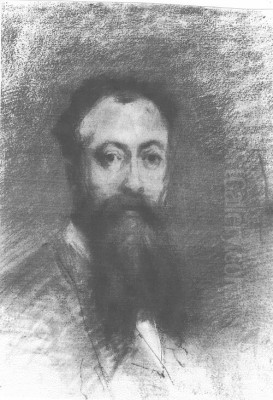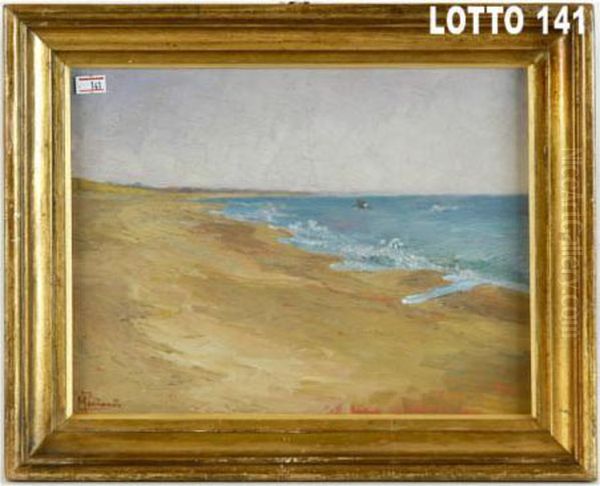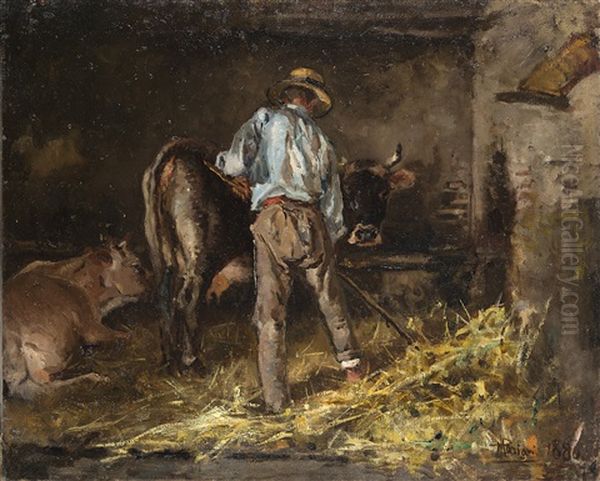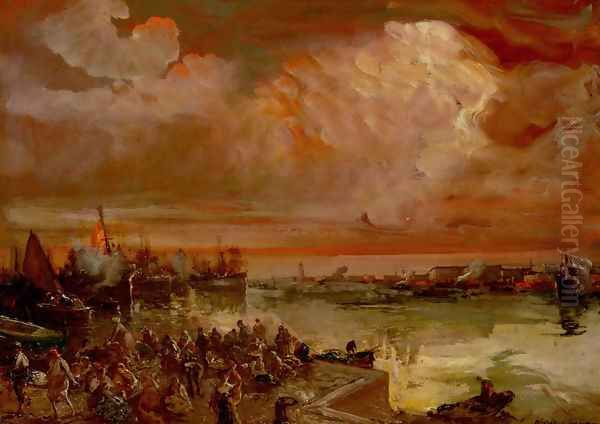
Pompeo Mariani stands as a significant figure in Italian art during the late nineteenth and early twentieth centuries. An accomplished painter and printmaker, he navigated the vibrant artistic currents of his time, developing a distinctive style rooted in observation yet imbued with a romantic sensibility. His work, particularly his luminous seascapes and lively depictions of society, captures the essence of Italy's Belle Époque.
Early Life and Artistic Calling
Born in Monza, in the province of Milan, on September 9, 1857, Pompeo Mariani initially seemed destined for a different path. His family background leaned towards finance, and he began a career in banking. However, the pull of art proved stronger, perhaps influenced by his uncle, the notable painter Mosè Bianchi, a prominent figure in the Lombard school. Mariani soon abandoned his financial pursuits to dedicate himself entirely to painting.
This decision marked the beginning of a lifelong commitment to capturing the world around him through an artistic lens. His early exposure to the Milanese art scene, likely facilitated by his uncle, would have provided initial inspiration and connections within the creative community of Lombardy.
Formative Training and Influences
Mariani's formal artistic education began in earnest in 1879 when he started studying under the guidance of Eleuterio Pagliano in Milan. Pagliano, himself a respected painter associated with historical subjects and Romanticism, provided Mariani with crucial foundational training. The curriculum under Pagliano emphasized "life studies," grounding Mariani's technique in careful observation and draughtsmanship.
During his time in Pagliano's studio, Mariani worked alongside other aspiring artists, including Uberto Dell'Orto and Spartaco Vela, fostering an environment of shared learning and artistic exploration. This period was crucial in honing his technical skills and shaping his artistic vision, moving beyond purely academic constraints towards a more personal interpretation of reality. The mentorship model, common at the time, allowed for direct transmission of technique and artistic philosophy.
Travels and Broadening Horizons

A pivotal experience in Mariani's early career was his journey to Egypt in 1881, undertaken with his friend and fellow artist Uberto Dell'Orto. This trip provided a wealth of exotic subjects and intense light conditions that profoundly impacted his palette and thematic interests. The sketches and studies made during this journey fueled his work for subsequent exhibitions, notably at the prestigious Brera Academy exhibitions in Milan over the next couple of years.
Following his return and initial successes, Mariani began spending significant time on the Ligurian coast, starting around 1883. This region, with its dramatic coastline, sparkling Mediterranean light, and picturesque fishing villages, became a central focus of his art. Initially drawn to landscape painting, he increasingly specialized in marine subjects, capturing the dynamic interplay of sea, sky, and shore.
Artistic Style: Romantic Impressionism
Pompeo Mariani is often categorized within Italian Impressionism, sometimes termed Romantic Impressionism. His style is characterized by a keen sensitivity to light and atmosphere, rendered with vibrant, harmonious colors and often energetic brushwork. While sharing the Impressionist interest in capturing fleeting moments and the effects of light, Mariani retained a strong sense of structure and detail rooted in his academic training.
He excelled at depicting the subtle nuances of weather – the haze over the water, the brilliance of sunlight on waves, the gathering of storm clouds. His paintings often combine meticulous observation of natural phenomena with an elegant, almost lyrical sensibility. This blend allowed him to portray not only the raw beauty of nature but also the sophisticated ambiance of the era's high society, particularly in his scenes from Monte Carlo or fashionable resorts.
Mariani's work reflects the optimism and dynamism of the late 19th century, often celebrating progress and the vibrancy of modern life. Whether depicting bustling harbors like Genoa, the tranquil greenery of Monza Park, or the lively crowds at social events, his paintings convey a sense of immediacy and engagement with the contemporary world. Beyond painting, he was also a skilled printmaker and etcher, exploring different mediums to express his artistic vision.
Major Works and Recognition
Throughout his career, Mariani produced a substantial body of work, gaining recognition both in Italy and internationally. One of his most notable commissions was the large canvas King Humbert I of Italy Reviewing the French Fleet Commanded by Admiral Rieunier, September 9, 1892. This significant historical painting demonstrated his ability to handle complex compositions and official subjects, and it found homes in important collections, including the Palace of Versailles and the Strasbourg Museum.

Other representative works showcase the breadth of his thematic interests: The Ball captures the elegance of high society gatherings, while Professional Roulette Players offers a glimpse into the world of the Monte Carlo Casino. His deep connection to the Ligurian coast is evident in paintings like Fishermen Returning from Bordighera and numerous works simply titled Marina (Seascape), which explore the varying moods of the Mediterranean.
His paintings frequently appear at auction, demonstrating continued appreciation. Works such as Marina, Nella stalla (In the Stable), Studio Pompeano Mariani (Pompeo Mariani's Studio), La battaglia delle piramidi (The Battle of the Pyramids), SCORCIO DI CAMPAGNA CON CONTADINA (View of Countryside with Peasant Woman), Genio (Genius), Spiazzo a Bordighera (Square in Bordighera), and DONNA AL BUCATO (Woman at the Wash Line) represent the diversity of his output, from grand historical echoes to intimate genre scenes and landscapes.
Mariani actively participated in the exhibition circuit of his time. He achieved significant success at the Venice Biennale, particularly noted for his showing in 1895. His work was regularly featured in major national and international exhibitions, where he received numerous official awards and medals, including accolades from Paris and Monaco, cementing his reputation among the leading Italian artists of his generation.
Villa Mariani: An Artistic Hub in Bordighera
Later in his life, Mariani established a significant presence in Bordighera, a town on the Italian Riviera favored by artists and international visitors. Here, he acquired and expanded a villa, known today as Villa Mariani. The original structure was designed by the renowned French architect Charles Garnier, famous for the Paris Opéra and the Monte Carlo Casino. Mariani enlarged the villa, creating not just a home and studio but also a vibrant cultural salon.
Villa Mariani became a meeting point for prominent figures from the worlds of art, music, and literature. Its beautiful gardens and elegantly decorated interiors provided an inspiring setting. Among the celebrated visitors were leading artists of the day, reflecting Mariani's standing in the international art community.
The guest list reportedly included the great French Impressionist Claude Monet, whose own work on the Riviera overlapped with Mariani's time there. The acclaimed American portraitist John Singer Sargent, known for his dazzling technique, also frequented the villa. Another significant visitor was the Spanish master of light, Joaquin Sorolla, whose vibrant beach scenes share some affinities with Mariani's coastal subjects.

The Russian landscape painter Isaac Levitan is also mentioned among the figures connected to the villa's circle, highlighting the international draw of the Riviera. Even royalty graced the villa, with Queen Margherita of Savoy, the Queen consort of Italy, being a notable guest. This underscores the villa's role as more than just a residence; it was a nexus of cultural exchange on the Ligurian coast.
Connections and Contemporaries
Pompeo Mariani's career unfolded within a rich tapestry of Italian and European art. His primary connections were naturally within the Lombard school, through his uncle Mosè Bianchi and his teacher Eleuterio Pagliano. His association with fellow students like Uberto Dell'Orto remained important, particularly in his early career.
His presence in Bordighera placed him in proximity to international artists like Monet, Sargent, and Sorolla. While direct artistic collaboration might not have been extensive, the shared environment and potential for exchange of ideas were significant. His work can be seen in dialogue with both French Impressionism and distinct Italian movements.
Compared to the earlier Macchiaioli group (including artists like Giovanni Fattori, Telemaco Signorini, and Silvestro Lega), who focused on capturing reality through patches ('macchie') of color and light, Mariani's style is generally smoother and more detailed, though sharing a commitment to outdoor painting and contemporary subjects.
He was also contemporary to the Italian Divisionists, such as Giovanni Segantini and Gaetano Previati, who experimented with applying paint in separate dots or strokes of color to create luminosity. While Mariani did not adopt their technique, his focus on light effects aligns with the broader interest in optical phenomena prevalent at the time. His work sits comfortably within the Milanese Scapigliatura movement's legacy, which emphasized capturing emotion and atmosphere, often with loose brushwork, seen in artists like Tranquillo Cremona and Daniele Ranzoni, though Mariani's style evolved towards greater clarity and brilliance.
Later Life and Legacy
Pompeo Mariani continued to paint actively throughout his life, dividing his time between Milan, Monza, and his beloved Bordighera. He remained a respected figure in the Italian art world until his death. Coincidentally, he passed away in Bordighera on his birthday, September 9, 1927.
His legacy is that of a versatile and prolific artist who masterfully captured the light, landscapes, and life of his time. He stands as a key representative of Italian Impressionism, particularly renowned for his evocative marine paintings that celebrate the beauty of the Ligurian coast. His work provides a valuable visual record of the era, from the elegance of high society to the daily lives of fishermen.
Posthumous exhibitions have continued to affirm his importance. A significant commemorative exhibition was held in Bordighera in 1956. His work was featured at the Galleria G. Cerruti in Milan in 1958, and more recently, his contributions were highlighted in a 2024 exhibition in Monza focusing on the artistic panorama of 19th-century Italy. These events ensure that the luminous world captured by Pompeo Mariani continues to be appreciated by new generations.
Conclusion
Pompeo Mariani remains an enduringly appealing artist, whose works bridge the academic traditions of the nineteenth century with the new sensibilities of Impressionism. His dedication to capturing the effects of light, his harmonious use of color, and his ability to evoke the atmosphere of specific places and moments define his contribution. As a painter of landscapes, seascapes, and the vibrant society of the Belle Époque, Mariani created a rich and lasting portrait of Italy at the turn of the twentieth century.